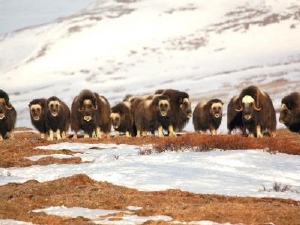Apr 24 2008
The Wildlife Conservation Society (WCS) recently launched a four-year study to determine if climate change is affecting populations of a quintessential Arctic denizen: the rare musk ox. Along with collaborators from the National Park Service, U. S. Geological Survey, and Alaska Fish and Game, Wildlife Conservation Society researchers have already equipped six musk ox with GPS collars to better understand how climate change may affect these relics of the Pleistocene.
 Musk ox are the subject of a new four-year study launched by the Wildlife Conservation Society and other groups. (Credit: Joel Berger/Wildlife Conservation Society)
Musk ox are the subject of a new four-year study launched by the Wildlife Conservation Society and other groups. (Credit: Joel Berger/Wildlife Conservation Society)
The research team will be assessing how musk ox are faring in areas along the Chukchi and northern Bering Seas, and the extent to which snow and icing events, disease, and possibly predation may be driving populations.
“Musk ox are a throwback to our Pleistocene heritage and once shared the landscape with mammoths, wild horses, and sabered cats,” said the study’s leader Dr. Joel Berger, a Wildlife Conservation Society scientist and professor at the University of Montana. “They may also help scientists understand how arctic species can or cannot adapt to climate change.”
Once found in Europe and Northern Asia, today musk ox are restricted to Arctic regions in North America and Greenland although they have been introduced into Russia and northern Europe. They have been reintroduced in Alaska after being wiped out in the late 19th century. Currently they found in two national parks: Alaska’s Bering Land Bridge National Park and Cape Krusenstem National Monument.
Next year, the team will collar an additional 30-40 more animals.